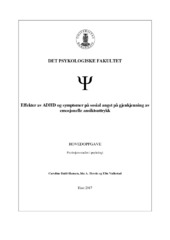| dc.contributor.author | Hovde, Ida Andrine | |
| dc.contributor.author | Dahl-Hansen, Caroline | |
| dc.contributor.author | Vallestad, Elin | |
| dc.date.accessioned | 2018-01-25T10:32:42Z | |
| dc.date.issued | 2017 | |
| dc.date.submitted | 2018-01-19T23:00:04Z | |
| dc.identifier.uri | https://hdl.handle.net/1956/17277 | |
| dc.description.abstract | The aim of the current experimental study was to investigate the influences of ADHD and symptoms of social anxiety on emotion recognition in faces. Norwegian youths aged 11-17 years with (n = 34) and without (n = 33) ADHD completed The Emotion Recognition Task (ERT). They also filled out the Social Phobia and Anxiety Inventory for Children (SPAI-C), a questionnaire measuring self-reported levels of social anxiety. A series of hierarchical linear regression analyses showed that higher levels of social anxiety predicted significantly more variable response time and a tendency to have a longer response time, also when controlling for ADHD. However, as expected, higher levels of social anxiety did not predict the number of correct answers on ERT. Univariate between-group analyses showed that the youths in the ADHD group specifically had significantly fewer correct answers on ERT than the control group. In addition, bivariate correlation analyses showed that the youths with ADHD had a higher frequency of choosing happy faces and a lower frequency of choosing sad faces than the controls. Symptoms of social anxiety did not correlate significantly with any of the emotions. The current findings suggest that typically co-occurring emotional problems with ADHD such as high levels of social anxiety is important to take into account when studying the effect of ADHD on emotion recognition. This indicates that anxiety may affect the social cognition of adolescents with ADHD. | en_US |
| dc.description.abstract | Formålet med denne studien var å undersøke hvordan ADHD og symptomer på sosial angst påvirker emosjonsgjenkjenning i ansiktsuttrykk. Norske ungdommer i alderen 11-17 år med (n = 34) og uten ADHD (n = 33) fullførte Emotion Recognition Task (ERT). De fylte også ut Social Phobia and Anxiety Inventory for Children (SPAI-C), et spørreskjema som måler selvrapporterte nivåer av sosial angst. En serie av hierarkiske lineære regresjonsanalyser viste at et høyere nivå av sosial angst predikerte en signifikant høyere variabilitet i latenstid og en tendens til lengere latenstid på ERT, også når det ble kontrollert for ADHD. Sosial angst predikerte ikke antall korrekte svar på ERT. Univariate mellomgruppeanalyser viste at ungdommene i ADHD-gruppen hadde spesifikt signifikant færre korrekte svar på ERT enn kontrollgruppen. I tillegg viste bivariate korrelasjonsanalyser at ungdommene med ADHD hadde en signifikant høyere frekvens av å velge glade ansikter, og en lavere frekvens av å velge triste ansikter, enn kontrollgruppen. Symptomer på sosial angst korrelerte ikke signifikant med noen av emosjonene. Funnene i denne studien tyder på det er viktig å ta hensyn til typiske emosjonelle problemer ved ADHD, som sosial angst, når en studerer emosjonsgjenkjenning. Dette kan tyde på at angst hos ungdommer med ADHD kan påvirke deres evne til sosial kognisjon. | en_US |
| dc.language.iso | nob | eng |
| dc.publisher | The University of Bergen | eng |
| dc.subject | ADHD | |
| dc.subject | Attention deficit hyperactivity disorder | |
| dc.subject | sosial angst | |
| dc.subject | social anxiety | |
| dc.subject | emotion recognition in faces | |
| dc.subject | emosjonsgjenkjenning i ansiktsuttrykk | |
| dc.title | Effekter av ADHD og symptomer på sosial angst på gjenkjenning av emosjonelle ansiktsuttrykk | eng |
| dc.type | Master thesis | |
| dc.date.updated | 2018-01-19T23:00:04Z | |
| dc.rights.holder | Copyright the Author. All rights reserved | eng |
| dc.description.degree | Hovedoppgave psykologprogrammet | |
| dc.description.localcode | PROPSY317 | |
| dc.subject.nus | 736102 | eng |
| fs.subjectcode | PROPSY317 | |
| fs.unitcode | 17-00-00 | |
